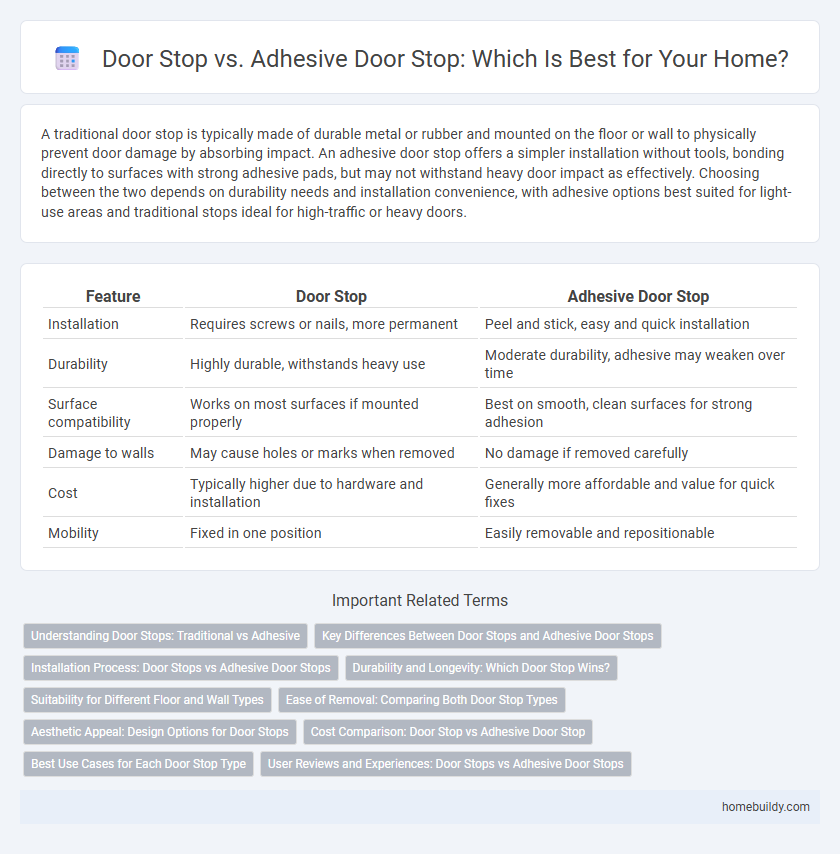A traditional door stop is typically made of durable metal or rubber and mounted on the floor or wall to physically prevent door damage by absorbing impact. An adhesive door stop offers a simpler installation without tools, bonding directly to surfaces with strong adhesive pads, but may not withstand heavy door impact as effectively. Choosing between the two depends on durability needs and installation convenience, with adhesive options best suited for light-use areas and traditional stops ideal for high-traffic or heavy doors.
Table of Comparison
| Feature | Door Stop | Adhesive Door Stop |
|---|---|---|
| Installation | Requires screws or nails, more permanent | Peel and stick, easy and quick installation |
| Durability | Highly durable, withstands heavy use | Moderate durability, adhesive may weaken over time |
| Surface compatibility | Works on most surfaces if mounted properly | Best on smooth, clean surfaces for strong adhesion |
| Damage to walls | May cause holes or marks when removed | No damage if removed carefully |
| Cost | Typically higher due to hardware and installation | Generally more affordable and value for quick fixes |
| Mobility | Fixed in one position | Easily removable and repositionable |
Understanding Door Stops: Traditional vs Adhesive
Door stops prevent door damage and wall marks by limiting door movement using physical barriers. Traditional door stops, often made of metal or rubber, are mounted on the floor or wall, offering durable fixed protection with minimal maintenance. Adhesive door stops provide a damage-free installation option, using strong adhesives for easy placement on surfaces, though they may offer less stability over time compared to traditional mounts.
Key Differences Between Door Stops and Adhesive Door Stops
Door stops are typically made of durable materials like metal or rubber and require screws for installation, providing long-lasting protection against door damage. Adhesive door stops use strong, double-sided tape for easy, drill-free installation but may not support heavy or frequent door impact as effectively. The choice depends on the need for sturdiness versus ease of installation, with traditional door stops offering superior stability and adhesive options favoring convenience.
Installation Process: Door Stops vs Adhesive Door Stops
Door stops typically require drilling into walls or floors for secure installation, ensuring long-term durability and stability. Adhesive door stops offer a simpler, tool-free installation process by sticking directly to surfaces, ideal for temporary or rental spaces. Choosing between the two depends on the desired permanence and ease of setup, with drilled stops providing more robust protection against door impact.
Durability and Longevity: Which Door Stop Wins?
Metal and rubber door stops offer superior durability compared to adhesive door stops, which can weaken over time due to adhesive failure. Mechanical door stops withstand repeated impact and environmental factors, ensuring long-term performance without detachment. In contrast, adhesive door stops often degrade with exposure to moisture and temperature changes, limiting their longevity and reliability.
Suitability for Different Floor and Wall Types
Traditional door stops offer versatile suitability for various floor materials such as hardwood, tile, and concrete, ensuring stable placement and durability. Adhesive door stops provide an effective solution for smooth, clean walls like painted drywall or glass, but may struggle on textured or porous surfaces, reducing adhesion longevity. Selecting the right door stop depends on surface texture and durability requirements, with fixed door stops favored for rough surfaces and adhesives for minimal damage on delicate walls.
Ease of Removal: Comparing Both Door Stop Types
Magnetic and rubber door stops offer straightforward removal by simply detaching or pulling them away from the door or wall surface. Adhesive door stops require more effort for removal, often involving heat or solvents to dissolve the adhesive and prevent residue or damage to paint and drywall. Choosing between these types depends on whether ease of removal or permanent installation is the priority.
Aesthetic Appeal: Design Options for Door Stops
Door stops come in various designs, materials, and finishes that complement different interior styles, enhancing the room's aesthetic appeal. Adhesive door stops offer sleek, low-profile options that blend seamlessly with walls or floors without the need for drilling, ideal for minimalist decors. Traditional door stops, available in polished metals, wood, or rubber, provide both functional durability and decorative accents, allowing customization to match door hardware and room themes.
Cost Comparison: Door Stop vs Adhesive Door Stop
Traditional door stops typically cost between $5 and $20 depending on material and design, offering durable protection for heavy use, while adhesive door stops range from $3 to $10, providing a budget-friendly and easy-to-install alternative. Adhesive versions may incur hidden costs due to potential replacements from adhesive failure or surface damage, whereas conventional door stops often involve a one-time cost with longer lifespan. When comparing total expenses, factoring in durability, maintenance, and installation, conventional door stops generally provide better long-term value despite a higher initial price.
Best Use Cases for Each Door Stop Type
Door stops with a solid base and mechanical mounting are best suited for heavy doors or high-traffic areas, providing durable and stable protection against wall damage. Adhesive door stops are ideal for lightweight or interior doors where ease of installation and minimal wall impact are priorities, offering a convenient, screw-free solution. Choosing between these types depends on door weight, wall surface, and long-term durability requirements.
User Reviews and Experiences: Door Stops vs Adhesive Door Stops
User reviews highlight that traditional door stops offer greater durability and stability, effectively preventing door damage over time. Adhesive door stops receive mixed feedback, with some users praising easy installation while others report adhesive failure on textured or uneven surfaces. Experiences suggest that choosing between the two depends on door weight and wall material, with door stops favored for heavy doors and adhesive stops suited for light-duty applications.
door stop vs adhesive door stop Infographic

 homebuildy.com
homebuildy.com